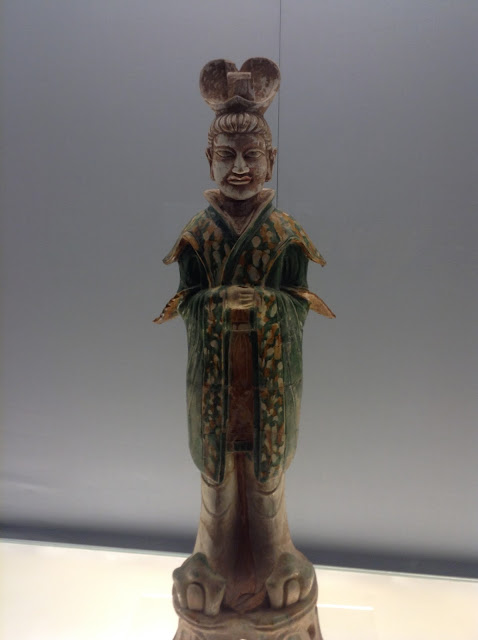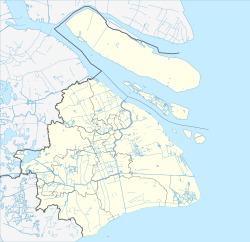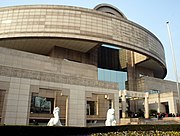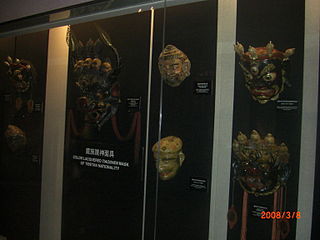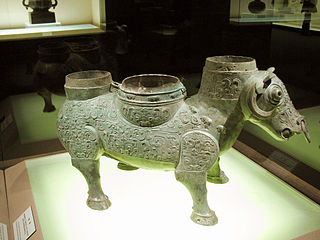SHANGHAI MUSEUM
Bảo tàng Thượng Hải nằm trong khuôn viên Công viên Nhân dân tại trung tâm thành phố.
Bảo tàng gồm 11 phòng trưng bày và 3 đại sảnh triển lãm, với các bộ sưu tập tác phẩm nghệ thuật và thủ công Trung Quốc cổ.
Musée de Shanghai

Cet article est une ébauche concernant le monde chinois.
Vous pouvez partager vos connaissances en l’améliorant (comment ?) selon les recommandations des projets correspondants.

Extérieur du bâtiment.

Intérieur du bâtiment.
Le musée de Shanghai (上海博物館) est un musée d'art chinois ancien situé à Puxi sur la Place du Peuple dans le district de Huangpu à Shanghai, Chine. L'entrée y est gratuite. Il est situé en face de la Mairie de Shanghai.
Sommaire
[masquer]
1Collections
2Histoire
3Galerie des collections
4Notes et références
5Voir aussi
5.1Lien externe
Collections[modifier | modifier le code]
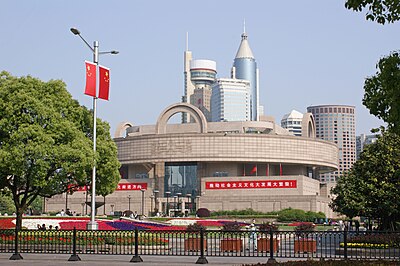
Le musée et son environnement en 2013.
Le musée est organisé en différentes salles répartissant sur trois étages les collections comme ci-dessous 1:
Calligraphie et peinture
Sculptures
Céramiques
Objets en bronze
Objets en jade
Sceaux
Meubles
Monnaies
Arts des minorités nationales
Le musée compte environ un million d'objets couvrant 21 domaines. Les collections de bronzes, de céramiques de calligraphies et de peintures sont particulièrement imposantes.
***********************
Shanghai Museum
 | |
Location within Shanghai
| |
| Established | 1952[1][2] |
|---|---|
| Location | 201 Renmin Avenue, People's Square, Shanghai, 200003[3] |
| Coordinates | 31.230278°N 121.470556°E |
| Visitors | 1.9 million (2013)[4] Ranking 23rd globally (2013)[4] |
| Director | Ma Chengyuan (1985–99) |
| Public transit access | People's Square Station on Lines 1, 2, and 8 (Shanghai Metro) |
| Website | www |
| Shanghai Museum | |||
| Simplified Chinese | 上海博物馆 | ||
|---|---|---|---|
| Traditional Chinese | 上海博物館 | ||
| |||
The Shanghai Museum is a museum of ancient Chinese art, situated on the People's Square in the Huangpu District of Shanghai, China. Rebuilt at its current location in 1996, it is considered one of China's first world-class modern museums.[5]
Contents
[hide]History[edit]
The museum was founded in 1952 and was first open to the public in the former Shanghai Racecourse club house, now at 325 West Nanjing Road.[6] The founding collections came principally from three sources: a batch of artefacts gathered by the Communist 3rd Field Army during the civil war from accidental finds and confiscations of private property and brought to Shanghai upon the Communists' conquest of the city; artefacts confiscated by the customs service; items sold by private collectors due to political pressure during political purges and purchased by the government. The former Shanghai Municipal Museum was also merged into the new Shanghai Museum.
In the next few years, the museum's collections were further enriched from other private and institutional collections in Shanghai, including the collection of the former Shanghai Museum of the Royal Asiatic Society, which were moved to the museum as "foreign" institutions gradually left the city in the 1950s. In 1959 the museum moved into the Zhonghui Building at 16 South Henan Road, which housed insurance companies and bank offices.[1][2] During the metal-gathering campaign of the Great Leap Forward, the Shanghai Museum participated in rescuing bronzeware from metal that had been confiscated or donated and were sent to be melted down. Before the Cultural Revolution, a tradition formed whereby Shanghai's wealthy collectors would make annual donations to the museum.
The museum's work largely halted as a result of the Cultural Revolution. After the end of the revolution, as one of China's most important museums, the collections have continued to be enriched with the fruit of donations, government purchases, and important finds from archaeological excavations.
The growth of its collections put enormous pressure on the cramped premises. For his role in ensuring a large, purpose-built home, it is said that Shanghai Museum owes much of its current existence to Ma Chengyuan, its director from 1985 until his retirement in 1999. When a new museum was omitted from Shanghai's five-year reconstruction plan in 1992, Ma lobbied Mayor Huang Ju for its rebuilding. After seeing the dilapidated rooms of the Zhonghui Building, Huang agreed to allocate a prime site on the People's Square, but the museum had to raise its own building funds.[5][7] Ma raised US$25 million by leasing the old building to a Hong Kong developer. He also made many trips abroad to solicit donations, mainly from the Shanghai diaspora who had fled to Hong Kong after the Communist revolution, raising another $10 million. The money still ran short, but he eventually won another 140 million yuan from the city government to complete the building.[5]
Construction of the current building started in August 1993. It was inaugurated on October 12, 1996[1] to wide acclaim.[7] It is 29.5 meters high with five floors, covering a total area of 39,200 m².[1]
Designed by local architect Xing Tonghe,[2] the building is designed in the shape of an ancient bronze cooking vessel called a ding. It is said that the inspiration for the design was specifically provided by the Da Ke Ding, now on exhibit in the museum. The building has a round top and a square base, symbolizing the ancient Chinese perception of the world as "round sky, square earth" (Chinese: 天圆地方[8]).
Collections[edit]
The museum has a collection of over 120,000 pieces, including bronze, ceramics, calligraphy, furniture, jades, ancient coins, paintings, seals, sculptures, minority art and foreign art. The Shanghai Museum houses several items of national importance, including one of three extant specimens of a "transparent" bronze mirror from the Han Dynasty.
Galleries[edit]
It has eleven galleries and three special temporary exhibition halls. The permanent galleries are:[9]
- Gallery of Ancient Chinese Bronze
- Gallery of Ancient Chinese Sculpture
- Gallery of Ancient Chinese Ceramics
- Gallery of Ancient Chinese Jades
- Gallery of Ancient Chinese Paintings
- Gallery of Ancient Chinese Calligraphy
- Gallery of Ancient Chinese Seals
- Gallery of Ancient Chinese Numismatics
- Gallery of Chinese furniture in Ming and Qing dynasties
- Gallery of Arts and Crafts by Chinese Minorities
Numismatic Collections[edit]
The Museum has an important collection of ancient coins from the Silk Road, donated since 1991 by Linda and Roger Doo. The collection contains 1783 pieces from the Greeks to the Mongol Empire.[10]
Selected publications[edit]
- Ancient Chinese Ceramic Gallery The Shanghai Museum. Shanghai: Shanghai Classics Publishing House, 1996. (English & Mandarin Chinese edition.) ISBN 7-5325-1721-7
See also[edit]
References[edit]
- ^ a b c d Shanghai Museum
- ^ a b c American Friends of the Shanghai Museum
- ^ Service Installation - Visitor's Information
- ^ a b Top 100 Art Museum Attendance, The Art Newspaper, 2014. Retrieved on 13 July 2014.
- ^ a b c Jasper Becker (3 January 2001). "Ma Chengyuan and the creation of Shanghai Museum". South China Morning Post. Retrieved 12 September 2013.
- ^ http://www.shanghaimuseum.net/en/history/history.jsp
- ^ a b "Ma Chengyuan, 77, President of Shanghai Museum, Dies". New York Times. 15 October 2004. Retrieved 9 September 2013.
- ^ Zhongshu, Zhao (1992-01-01). "Round Sky and Square Earth (Tian Yuan Di Fang): Ancient Chinese Geographical Thought and its Influence". GeoJournal. 26 (2): 149–152.
- ^ Shanghai Museum
- ^ Chen, Doo, and Wang, 2006
***************************************************************************************

Cet article est une ébauche concernant le monde chinois.
Vous pouvez partager vos connaissances en l’améliorant (comment ?) selon les recommandations des projets correspondants.

Extérieur du bâtiment.

Intérieur du bâtiment.
Le musée de Shanghai (上海博物館) est un musée d'art chinois ancien situé à Puxi sur la Place du Peuple dans le district de Huangpu à Shanghai, Chine. L'entrée y est gratuite. Il est situé en face de la Mairie de Shanghai.
Sommaire
[masquer]
1Collections
2Histoire
3Galerie des collections
4Notes et références
5Voir aussi
5.1Lien externe
Collections[modifier | modifier le code]

Le musée et son environnement en 2013.
Le musée est organisé en différentes salles répartissant sur trois étages les collections comme ci-dessous 1:
Calligraphie et peinture
Sculptures
Céramiques
Objets en bronze
Objets en jade
Sceaux
Meubles
Monnaies
Arts des minorités nationales
Le musée compte environ un million d'objets couvrant 21 domaines. Les collections de bronzes, de céramiques de calligraphies et de peintures sont particulièrement imposantes.
Histoire[modifier | modifier le code]
Avant 1949 et la proclamation de la République Populaire de Chine, Shanghai accueille parmi les plus grands marchés aux antiquités de l’Asie de l’Est et a un statut de plaque tournante dans le milieu de l’art traditionnel2. Par la suite, le Parti Communiste Chinois met fin à ses marchés et ordonne la confiscation de nombreuses œuvres. Toutefois, en 1952, le premier musée d’art de Shanghai ouvre sur la Nanjing Xi Lu, à l’emplacement de l’ancien Club des courses hippiques. Ma Chengyuan, et Wang Qingzheng (qui deviennent ensuite respectivement directeur et vice-directeur du Musée de Shanghai) rejoignent l’équipe de ce premier musée peu après sa création. Ma Chengyuan participe à la sélection de quelque 13 000 bronzes, peintures, jades, calligraphies, meubles qui constitueront la collection primitive du musée.
Avant 1949 et la proclamation de la République Populaire de Chine, Shanghai accueille parmi les plus grands marchés aux antiquités de l’Asie de l’Est et a un statut de plaque tournante dans le milieu de l’art traditionnel2. Par la suite, le Parti Communiste Chinois met fin à ses marchés et ordonne la confiscation de nombreuses œuvres. Toutefois, en 1952, le premier musée d’art de Shanghai ouvre sur la Nanjing Xi Lu, à l’emplacement de l’ancien Club des courses hippiques. Ma Chengyuan, et Wang Qingzheng (qui deviennent ensuite respectivement directeur et vice-directeur du Musée de Shanghai) rejoignent l’équipe de ce premier musée peu après sa création. Ma Chengyuan participe à la sélection de quelque 13 000 bronzes, peintures, jades, calligraphies, meubles qui constitueront la collection primitive du musée.
En 1959, le musée déménage dans les bâtiments de la banque Zhong Hui sur la Henan Nan Lu, la majeure partie des antiquités est emballée et stockée dans les coffres forts de la banque. Les œuvres jouissent d’une protection officielle jusqu’à la Révolution Culturelle de 1966-76 et l’appel de Mao à détruire toutes les reliques de la Chine prérévolutionnaire. Pour protéger la collection des Gardes Rouges, Ma Chengyuan dort alors dans son bureau, reçoit les appels des collectionneurs apeurés, répartit le travail des employés du musée afin qu’ils protègent et répertorient les œuvres d’art. Devançant les ennuis, Monsieur Ma ordonne à son équipe de se grimer en Gardes Rouges et peint des slogans révolutionnaires sur les vitrines d’exposition. Mais la résistance prend soudain une tournure nouvelle : l’équipe du musée se scinde. La faction la plus extrémiste emprisonne et torture Ma Chengyuan et ses alliés pendant neuf mois dans la réserve du musée, cherchant à faire avouer à Ma qu’il a vendu des objets du musée pour son propre compte. Ce dernier ne cède pas et est finalement envoyé cinq ans dans un camp de travail pour les fonctionnaires de Shanghai à Hubbei. Il ne retourne à Shanghai qu’en 1972 pour organiser une exposition d’œuvres chinoises aux États-Unis, après la venue du Président Nixon en Chine. Une partie importante de la collection a été sauvée et cachée hors de Shanghai dans des dépôts souterrains des montagnes du sud de l’Anhui.
Ma Chengyuan est nommé directeur du musée au début des années 1990. Il entreprend un travail de prospection, cherche à lever des fonds publics et privés (notamment auprès des riches collectionneurs de Hong-Kong) afin de reloger le musée dans un bâtiment plus approprié. En 1992, la municipalité de Shanghai alloue une parcelle au Musée en plein centre de la ville, sur la Place du Peuple ; la construction prend trois ans et le musée ouvre finalement en 1996.
Le bâtiment est constitué d'une base carrée et d'un plafond rond, évoquant un ding, récipient en bronze utilisé pour des offrandes à l'époque Shang. La forme réfère à une notion philosophique chinoise du confucianisme où un ciel rond couvre la terre carrée. À l'entrée sud, on retrouve huit sculptures de lions en jade blanc.
Galerie des collections[modifier | modifier le code]

Hache d'arme de bronze yue, avec incrustations de turquoise en forme croix. Culture d'Erlitoufinale, xvie siècle AEC

Vase dui: offrandes de céréales. Bronze incrusté de motifs géométriques en cuivre. H. 28 cm. Fin Royaumes combattants (fin IVe s.-220 AEC).

Figurine mingqi d'un paysan de l'époque Han. Terre cuite peinte

Urne funéraire, grèscéladon de Yue. Sur l'ouverture : Pavillon et personnages. Décor moulé sur la panse. Jin occidentaux (265-316).

Ornement de jade à décor de vigne. Dynastie Jin (265-420)

Un cavalier sur son cheval. Céramique funéraire mingqi aux trois couleurs, H. 40 cm env.. Tang
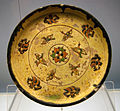
Plat à offrandes Tang d'inspiration sassanide, Chine du Nord, viiie siècle, céramique aux "trois couleurs" sur engobe, décor incisé, D. 30 cm env.

Six gentihommes, Ni Zan, 1345, rouleau mural, encre sur papier, 61,9 × 33,3 cm

Calligraphie de Wen Zhengming(1508 - 1588) évoquant le portrait de Ni Zan. Encre sur soie
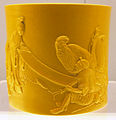
Pot à pinceaux de lettré, porcelaine de Jingdezhen. Dynastie Qing

Table et ses sièges, bois laqué ciselée.

Ensemble féminin de l'ethnie Dai. Xishuangbanna, Yunnan. Broderie chinoise
Le bâtiment est constitué d'une base carrée et d'un plafond rond, évoquant un ding, récipient en bronze utilisé pour des offrandes à l'époque Shang. La forme réfère à une notion philosophique chinoise du confucianisme où un ciel rond couvre la terre carrée. À l'entrée sud, on retrouve huit sculptures de lions en jade blanc.
Galerie des collections[modifier | modifier le code]

Hache d'arme de bronze yue, avec incrustations de turquoise en forme croix. Culture d'Erlitoufinale, xvie siècle AEC

Vase dui: offrandes de céréales. Bronze incrusté de motifs géométriques en cuivre. H. 28 cm. Fin Royaumes combattants (fin IVe s.-220 AEC).

Figurine mingqi d'un paysan de l'époque Han. Terre cuite peinte

Urne funéraire, grèscéladon de Yue. Sur l'ouverture : Pavillon et personnages. Décor moulé sur la panse. Jin occidentaux (265-316).

Ornement de jade à décor de vigne. Dynastie Jin (265-420)

Un cavalier sur son cheval. Céramique funéraire mingqi aux trois couleurs, H. 40 cm env.. Tang

Plat à offrandes Tang d'inspiration sassanide, Chine du Nord, viiie siècle, céramique aux "trois couleurs" sur engobe, décor incisé, D. 30 cm env.

Six gentihommes, Ni Zan, 1345, rouleau mural, encre sur papier, 61,9 × 33,3 cm

Calligraphie de Wen Zhengming(1508 - 1588) évoquant le portrait de Ni Zan. Encre sur soie

Pot à pinceaux de lettré, porcelaine de Jingdezhen. Dynastie Qing

Table et ses sièges, bois laqué ciselée.

Ensemble féminin de l'ethnie Dai. Xishuangbanna, Yunnan. Broderie chinoise
Notes et références[modifier | modifier le code]
↑ Le musée sur la page « Shanghai » de SiteMAI [archive]
↑ Jennifer Thiault, Le Musée de Shanghai, Shanghai, Bouquins (Robert Laffont, 2010, (ISBN 222111096X))
↑ Le musée sur la page « Shanghai » de SiteMAI [archive]
↑ Jennifer Thiault, Le Musée de Shanghai, Shanghai, Bouquins (Robert Laffont, 2010, (ISBN 222111096X))





















































































































